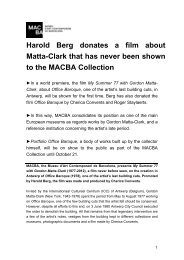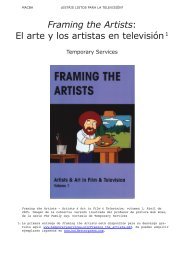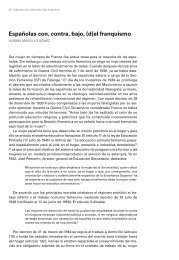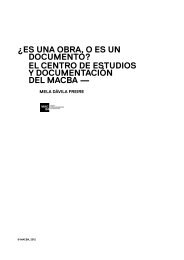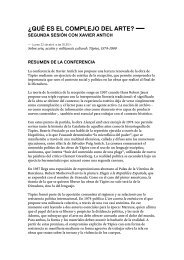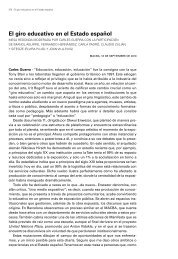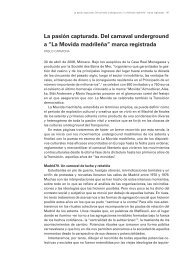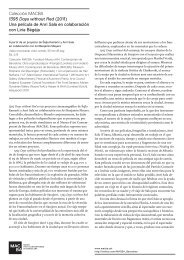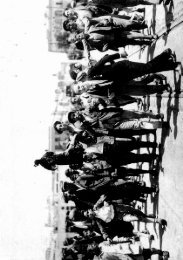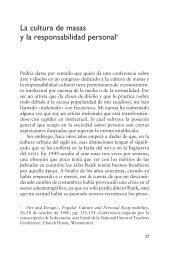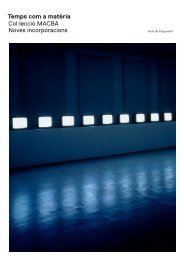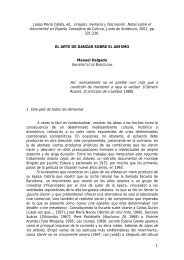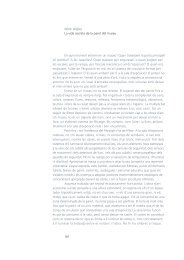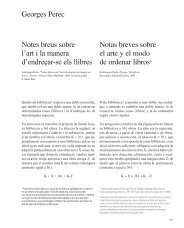Chance, Indeterminacy, Multiplicity - Macba
Chance, Indeterminacy, Multiplicity - Macba
Chance, Indeterminacy, Multiplicity - Macba
You also want an ePaper? Increase the reach of your titles
YUMPU automatically turns print PDFs into web optimized ePapers that Google loves.
80. Cage, “Experimental Music:<br />
Doctrine,” p. 14.<br />
81. Ibid.<br />
82. Cage, “45’ for a Speaker,” p. 149.<br />
83. Ibid., p. 189. Cage’s invocation of<br />
“theater” was doubtlessly related to<br />
his reception of Antonin Artaud, whose<br />
work he studied in 1951–52. See Cage’s<br />
comments in his letter to Boulez, May<br />
22, 1951, in Nattiez, (ed.), p. 96.<br />
84. The Audio Visual Group is mentioned<br />
in Joseph Jacobs, “Crashing New<br />
York à la John Cage,” in Joan Marter,<br />
(ed.), Off Limits: Rutgers University<br />
and the Avant-Garde, 1957–1963, New<br />
Brunswick, N. J.: Rutgers University<br />
Press, 1999, p. 73. On the notion<br />
of Cagean “theater,” see Branden W.<br />
Joseph, “The Tower and the Line:<br />
Toward a Genealogy of Minimalism,”<br />
Grey Room No. 27, spring 2007, pp.<br />
58–81, and (a reworking of some of the<br />
same material) Beyond the Dream<br />
Syndicate: Tony Conrad and the Arts<br />
after Cage, New York: Zone Books,<br />
2008, esp. pp. 81–84.<br />
85. Diane De Bonneval, “New<br />
School’s ‘Happenings’ Proves to be<br />
‘Hellzapoppin’ – Beatnik Style,”<br />
New York World-Telegram and Sun,<br />
May 3, 1960, in Hermann Braun,<br />
(ed.), George Brecht, Notebook V<br />
(March 1960–November 1960),<br />
Cologne: Walther König, 1997, p. 89.<br />
all facets of existence. As Cage explained in “Experimental Music:<br />
Doctrine” in 1955:<br />
Urgent, unique, uninformed about history and theory, beyond the imagination,<br />
central to a sphere without surface, its [a sound’s] becoming is unimpeded,<br />
energetically broadcast. There is no escape from its action. It does not exist as one<br />
of a series of discrete steps, but as transmission in all directions from the field’s<br />
center. It is inextricably synchronous with all other, sounds, non-sounds, which<br />
latter, received by other sets than the ear, operate in the same manner. 80<br />
From such a perspective, Cage’s idea of the “field” extended into<br />
the multisensory, multimedia, and multidisciplinary realm he<br />
termed “theater”:<br />
Relevant action is theatrical (music [imaginary separation of hearing from<br />
the other senses] does not exist), inclusive and intentionally purposeless. Theater<br />
is continually becoming that it is becoming; each human being is at the best<br />
point for reception. Relevant response (getting up in the morning and discovering<br />
oneself musician) (action, art) can be made with any number (including none<br />
[none and number, like silence and music, are unreal]) of sounds. 81<br />
One year earlier, in “45’ for a Speaker,” Cage had specifically invoked<br />
the relation of sound and vision, writing:<br />
Music is an oversimplification of the situation we actually are in. An ear alone<br />
is not a being; music is one part of theater. “Focus” is what aspects one’s noticing.<br />
Theater is all the various things going on at the same time. I have noticed that music<br />
is liveliest for me when listening for instance doesn’t distract me from seeing. 82<br />
Anticipating the partial conjunction of his own discipline with<br />
that of most of his New School students, Cage noted further,<br />
“it is theater and music disappears entirely into the realm of art<br />
where it knows it belongs.” 83<br />
Although by no means deriving exclusively from Cage’s example,<br />
the genres of happenings and Fluxus drew greatly upon Cage’s<br />
extension of composition to include the visual as well as the audible,<br />
objects and environments as well as sounds. Kaprow’s first<br />
happenings, Brecht’s early experiments with light, and Hansen,<br />
Higgins, and Larry Poons’s founding of the Audio Visual Group<br />
can all be understood as developments of Cagean “theater.” 84 In<br />
1960, even as Kaprow had become the happening’s official spokesperson,<br />
the genre was received as indelibly linked to Cage’s New<br />
School classroom and its practitioners identified as his students. 85<br />
Even as late as 1961, a year after Cage had stopped teaching, Brecht<br />
could still be found working through Cage’s theatrical paradigm.<br />
In the draft of an article proposed for the nascent publication,<br />
Fluxus, Brecht wrote:<br />
231



